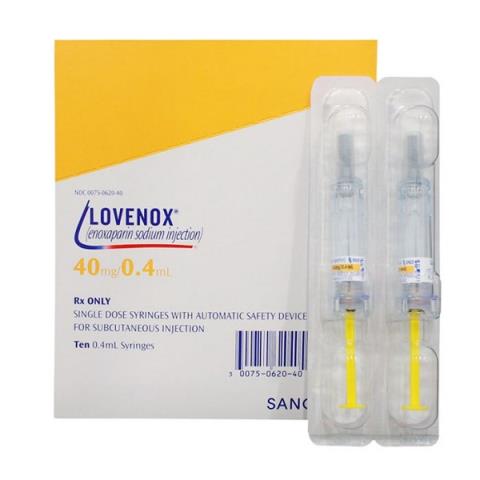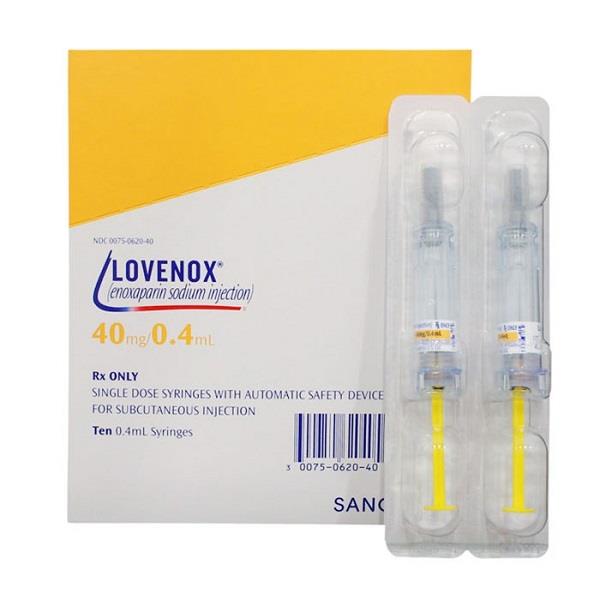Anticoagulant Lovenox (enoxaparin): What did you know?

What is Lovenox (enoxaparin)? What is Lovenox (enoxaparin) used for? What should be noted about possible side effects while taking the drug? Let's take a closer look at SignsSymptomsList about Lovenox (enoxaparin) in the article analyzed below!
Active ingredient: Enoxaparin
Drugs with similar ingredients: Enoxaplen; Troynoxa-60.
content
- 1. What is Lovenox?
- 2. Indications of Lovenox
- 3. Lovenox should not be used if:
- 4. How to use Lovenox effectively
- 5. Lovenox drug side effects
- 6. Interaction occurs when taking Lovenox
- 7. Notes when using Lovenox
- 8. Special Uses
- 9. Treatment of Lovenox overdose
- 10. What to do when you miss a dose of Lovenox
- 11. How to preserve
1. What is Lovenox?
1.1. Specific dosage forms and strengths
- Prefilled syringe (preservative free): 20 mg/0.2 ml, 30 mg/0.3 ml, 40 mg/0.4 ml.
- Pre-filled syringe (no preservatives): 60 mg/0.6 ml, 80 mg/0.8 ml, 100 mg/1 ml, 120 mg/0.8 ml, 150 mg/1 ml.
- Multi-dose vial (containing benzyl alcohol): 300 mg/3 ml.
1.2. Uses of Enoxaparin
This is a low-molecular-weight heparin, accounting for about one-third of the molecular mass of common heparin.
The drug has an anticoagulant effect.

Lovenox (enoxaparin)
2. Indications of Lovenox
Used in the prevention of VTE in moderate or high risk surgery such as in:
- Hip and knee replacement surgery.
- Abdominal surgery in people over 40 years old, obese).
- In medical cases (if you have to lie down for a long time due to prolonged illness).
In addition, Levonox also helps to prevent blood clotting in the extracorporeal circulation when hemodialysis lasts ≤ 4 hours.
Not only that, the drug can prevent deep vein thrombosis in patients at risk of:
- Heart failure grade III or IV, acute respiratory failure
- Acute infection or acute rheumatic fever with risk of venous thromboembolism
Treatment of the following conditions:
- Deep vein thrombosis is present.
- Unstable angina and non-Q-wave myocardial infarction in the acute phase, in combination with aspirin .
- Acute ST-segment elevation myocardial infarction.
3. Lovenox should not be used if:
- Allergy to enoxaparin, heparin or preparations derived from animals.
- Patients with hypersensitivity to benzylic alcohol (only when using a multidose vial).
- Have had thrombocytopenia due to heparin in the past.
- Bleeding or at risk of bleeding due to blood clotting disorders, trauma.
- Contraindicated for children <3 years old="" vial="" drug="" injection="" 300="" mg/3="" ml="" do="" yes="" alcohol=" ">
- For people with severe renal failure (Clcr < 30="" ml/min)="" minus="" when="" dialysis="">
- When treated with low-molecular-weight heparin, do not administer epidural or spinal anesthesia or lumbar puncture because of the risk of intra-canal hematoma with serious consequences.
4. How to use Lovenox effectively
4.1. How to use
- Enoxaparin is injected subcutaneously (except in hemodialysis).
- Do not use the drug by intramuscular route.
- Note, do not push the air in the syringe out to avoid losing the drug.
- Injection position for the patient: lying down, in the anterior - lateral and posterior - left and right abdominal wall.
- Note, must be injected perpendicularly into the skin fold, submerged the length of the transparent needle when injecting the drug. For each injection, the site must be changed.
4.2. Amount
4.2.1. Prophylaxis of venous thromboembolism
- Use for 7-10 days or until the patient can walk.
- For mild to moderate risk, 20 mg once daily. The first dose is given 2 hours before surgery.
- In high-risk patients, the dose must be increased to 40 mg/time/day; Initial dose administered 12 hours before surgery.
- Alternatively, use a dose of 30 mg subcutaneously x 2 times / day, the
first injection after surgery within 12 to 24 hours. - After hip and knee surgery, Levonox injection can be continued at a dose of 40 mg/time/day for the next 3 weeks.
4.2.2. Treatment of deep vein thrombosis
- Subcutaneous injection at a dose of 1 mg/kg (100 units/kg) x 2 times/day.
- Or 1.5 mg/kg (150 units/kg)/time/day for at least 5 days or until oral anticoagulant is used (in pregnant patients, the dose must be calculated according to body weight at the beginning of pregnancy) .
4.2.3. Prevention of blood clotting in the extracorporeal circulation
- Intra-arterial system injection 1 mg/kg (100 units/kg) at the start of dialysis.
- A dose of 0.5-1 mg (50-100 units/kg) may be added if needed.
- Note, for people at high risk of bleeding, reduce to 1/2 or 3/4 dose.
4.2.4 Treatment of unstable angina and non-Q wave myocardial infarction
- The dose is 1 mg/kg (100 units/kg), subcutaneously x 2 times/day.
- Treatment usually lasts 2-8 days and is accompanied by low-dose aspirin (100-325 mg/time/day).
4.2.5. Treatment of acute ST-segment elevation myocardial infarction
- Initiation is 30 mg (3000 units/kg) intravenously with a single subcutaneous dose of 1 mg/kg (100 units/kg) administered at the same time.
- Subsequent doses are administered subcutaneously 1 mg/kg (100 units/kg) x 2 times/day x 8 days or until hospital discharge.
- The first two subcutaneous doses of ≤100 mg (10 000 units) each.
- For patients undergoing percutaneous coronary intervention, an additional intravenous dose of 300 micrograms/kg (30 units/kg) must be given at the time of procedure if the last subcutaneous dose given earlier has been exceeded. 8 o'clock.
- Patients >75 years of age with acute myocardial infarction, should be given subcutaneous dose only.
+ The recommendation is 750 micrograms/kg (75 units/kg) x 2 times/day, with the first two subcutaneous doses ≤75 mg each (7 500 units).
+ Maintenance: After the first 2 doses, give subcutaneous injection of 750 micrograms/kg x 2 times/day
Note, the doses mentioned above are for reference only. Depending on the age, medical condition as well as physiological function in the body, the doctor will advise and prescribe different specific doses.
5. Lovenox drug side effects
- Major bleeding (intracranial bleeding, retroperitoneal bleeding, intraocular bleeding, indication/population variability, mild and early thrombocytopenia, anemia).
- Fever, pain.
- Erythema, bruising.
- Vomiting, diarrhea.
- Increase liver enzymes.
- Hematoma at injection site, local reaction causing irritation, pain, ecchymosis, erythema.
- Hematoma in the spine (when used with spinal anesthesia).
- Thrombocytopenia due to allergic immunity.
- Eczema, erythema, pruritus, urticaria, vesicular rash, purpura, skin vasculitis (hypersensitivity) appear.
- Causes skin necrosis at the injection site.
- Hyperkalemia, hyperlipidemia, hypertriglyceridemia.
- Osteoporosis with prolonged use.
6. Interaction occurs when taking Lovenox
- Potassium salt
- Potassium-sparing diuretics, ACE inhibitors, angiotensin II inhibitors, NSAIDs
- The heparin
- Cyclosporin, tacrolimus and trimethoprim.
- Salicylates, dipyridamol, sulfinpyraxone
- dextran 40 . injection
7. Notes when using Lovenox
- Caution should be exercised when administering to patients with recent or epidural or spinal anesthesia because of the risk of epidural or intra-spinal hematoma leading to prolonged or permanent paralysis.
- Bleeding should be closely monitored if the drug is administered during or shortly after lumbar puncture for diagnostic, epidural, or spinal anaesthesia.
- There are no adequate studies in prosthetic heart valve carriers.
- Not to be used as an alternative to heparin or any other low-molecular-weight heparin.
- Of note, use with caution in patients with a history of heparin-induced thrombocytopenia.
- Monitor patients closely for signs or symptoms of bleeding.
- Levonox dose adjustment and careful monitoring is necessary for low-birth-weight subjects (female < 45="" kg,="" male="">< 57="" kg="" because "yes="" can ="" yes="" risk="" muscle="" bleeding="" blood="" high="">
with prophylactic dose) or subjects with renal failure (Clcr < 30="">
8. Special Uses
8.1. Pregnant women
- Enoxaparin does not cross the placenta.
- All patients taking anticoagulants such as enoxaparin, including pregnant women, are at risk of bleeding.
- Of note, bleeding can occur at any site and can lead to maternal and/or fetal death.
- Therefore, special consideration should be given to the use of a less effective anticoagulant in the near future.
8.2. Breastfeeding Women
- Currently, there are no contraindications to the use of Levonox in nursing mothers.
- This is because it is still uncertain whether the drug is absorbed from the digestive system of a nursing infant.
- However, to ensure safety, it is necessary to carefully weigh the benefits and risks before using it.
9. Treatment of Lovenox overdose
When overdose, the patient mainly has heavy bleeding.
Treat each condition specifically, but still focus on treating symptoms:
- Severe bleeding due to subcutaneous injection overdose, may prescribe protamine sulfate and some other notes
- Administration of protamine sulfate may cause severe hypotension and anaphylactic reactions. Since fatal reactions, often resembling anaphylaxis, have been reported with protamine sulfate, they should be administered only when resuscitation techniques and management of anaphylaxis have been prepared.
The patient should be taken to a nearby hospital immediately for prompt treatment.
10. What to do when you miss a dose of Lovenox
- Use as soon as you remember that you have missed a dose.
- If the missed dose is close to the next dose. Skip the missed dose and follow the dosing schedule.
- Do not take a double dose to make up for the missed dose.
11. How to preserve
- Keep Lovenox out of reach of children and pets.
- Store the medicine in a cool, dry place. Avoid exposure to direct light or keep the medicine in humid places.
- The best storage temperature is <30>
Above is the information on the use of anticoagulant Lovenox . Call your doctor immediately if you have any unusual symptoms so that they can be treated and supported promptly!